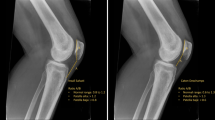Abstract
Anthropometric patellar dimensions can influence implant design and surgical techniques in patellar resurfacing for TKA. We measured anthropometric patellar dimensions in 752 osteoarthritic knees (713 in females and 39 in males) treated with TKA in 466 Korean patients and compared them with reported dimensions for Western patients. We investigated the effects of postoperative overall thickness deviations, residual bony thickness after bone resection, and postoperative deviations of component center positions from median ridge positions versus clinical and radiographic outcomes evaluated 1 year after surgery. Korean patients undergoing TKA had thinner and smaller patellae than Western patients. We found no associations between preoperative to postoperative overall thickness differences and clinical and radiographic outcomes and no differences between knees with a residual bony thickness 12 mm or greater and knees with a residual thickness less than 12 mm, with the exception of WOMAC pain scores. We found no associations between postoperative deviations of component center position and clinical or radiographic outcomes. Our findings indicate bone resection for patellar resurfacing can be flexible without jeopardizing clinical outcome.
Level of Evidence: Level IV, prognostic study. See the Guidelines for Authors for a complete description of levels of evidence.




Similar content being viewed by others
References
Baldwin JL, House CK. Anatomic dimensions of the patella measured during total knee arthroplasty. J Arthroplasty. 2005;20:250–257.
Bellamy N, Buchanan WW, Goldsmith CH, Campbell J, Stitt LW. Validation study of WOMAC: a health status instrument for measuring clinically important patient relevant outcomes to antirheumatic drug therapy in patients with osteoarthritis of the hip or knee. J Rheumatol. 1988;15:1833–1840.
Bindelglass DF, Cohen JL, Dorr LD. Patellar tilt and subluxation in total knee arthroplasty: relationship to pain, fixation, and design. Clin Orthop Relat Res. 1993;286:103–109.
Chmell MJ, McManus J, Scott RD. Thickness of the patella in men and women with osteoarthritis. Knee. 1995;2:239–241.
Feller JA, Bartlett RJ, Lang DM. Patellar resurfacing versus retention in total knee arthroplasty. J Bone Joint Surg Br. 1996;78:226–228.
Greenfield MA, Insall JN, Case GC, Kelly MA. Instrumentation of the patellar osteotomy in total knee arthroplasty: the relationship of patellar thickness and lateral retinacular release. Am J Knee Surg. 1996;9:129–131; discussion, 131–132.
Hitt K, Shurman JR 2nd, Greene K, McCarthy J, Moskal J, Hoeman T, Mont MA. Anthropometric measurements of the human knee: correlation to the sizing of current knee arthroplasty systems. J Bone Joint Surg Am. 2003;85(suppl 4):115–122.
Hsu HC, Luo ZP, Rand JA, An KN. Influence of patellar thickness on patellar tracking and patellofemoral contact characteristics after total knee arthroplasty. J Arthroplasty. 1996;11:69–80.
Huberti HH, Hayes WC. Patellofemoral contact pressures: the influence of q-angle and tendofemoral contact. J Bone Joint Surg Am. 1984;66:715–724.
Koh JS, Yeo SJ, Lee BP, Lo NN, Seow KH, Tan SK. Influence of patellar thickness on results of total knee arthroplasty: does a residual bony patellar thickness of ≤12 mm lead to poorer clinical outcome and increased complication rates? J Arthroplasty. 2002;17:56–61.
Merchant AC, Mercer RL, Jacobsen RH, Cool CR. Roentgenographic analysis of patellofemoral congruence. J Bone Joint Surg Am. 1974;56:1391–1396.
Merkow RL, Soudry M, Insall JN. Patellar dislocation following total knee replacement. J Bone Joint Surg Am. 1985;67:1321–1327.
Oishi CS, Kaufman KR, Irby SE, Colwell CW Jr. Effects of patellar thickness on compression and shear forces in total knee arthroplasty. Clin Orthop Relat Res. 1996;331:283–290.
Police P, Lotke PA, Lonner JH. Principles of instrumentation and component alignment. In: Callaghan JJ, Rosenberg AG, Rubash HE, Simonian PT, Wickiewicz TL, eds. The Adult Knee. Philadelphia, PA: Lippincott Williams & Wilkins; 2003:1085–1093.
Rauh MA, Bayers-Thering M, Buyea CM, Phillips M, Krackow KA. Reliability and validity of a new caliper for measuring patellar thickness. J Arthroplasty. 2002;17:105–107.
Reuben JD, McDonald CL, Woodard PL, Hennington LJ. Effect of patella thickness on patella strain following total knee arthroplasty. J Arthroplasty. 1991;6:251–258.
Ritter MA, Pierce MJ, Zhou H, Meding JB, Faris PM, Keating EM. Patellar complications (total knee arthroplasty): effect of lateral release and thickness. Clin Orthop Relat Res. 1999;367:149–157.
Star MJ, Kaufman KR, Irby SE, Colwell CW Jr. The effects of patellar thickness on patellofemoral forces after resurfacing. Clin Orthop Relat Res. 1996;322:279–284.
Acknowledgments
We thank Dr. Sung Ju Kim (Department of Statistics, Korea University, Seoul, Korea) for help with statistical analyses.
Author information
Authors and Affiliations
Corresponding author
Additional information
One or more of the authors (TKK, CBC) have received funding from the clinical research fund (B-0708/048-103) of Seoul National University Bundang Hospital.
Each author certifies that his or her institution has approved the human protocol for this investigation, that all investigations were conducted in conformity with ethical principles of research, and that informed consent was obtained.
About this article
Cite this article
Kim, T.K., Chung, B.J., Kang, Y.G. et al. Clinical Implications of Anthropometric Patellar Dimensions for TKA in Asians. Clin Orthop Relat Res 467, 1007–1014 (2009). https://doi.org/10.1007/s11999-008-0557-0
Received:
Accepted:
Published:
Issue Date:
DOI: https://doi.org/10.1007/s11999-008-0557-0




